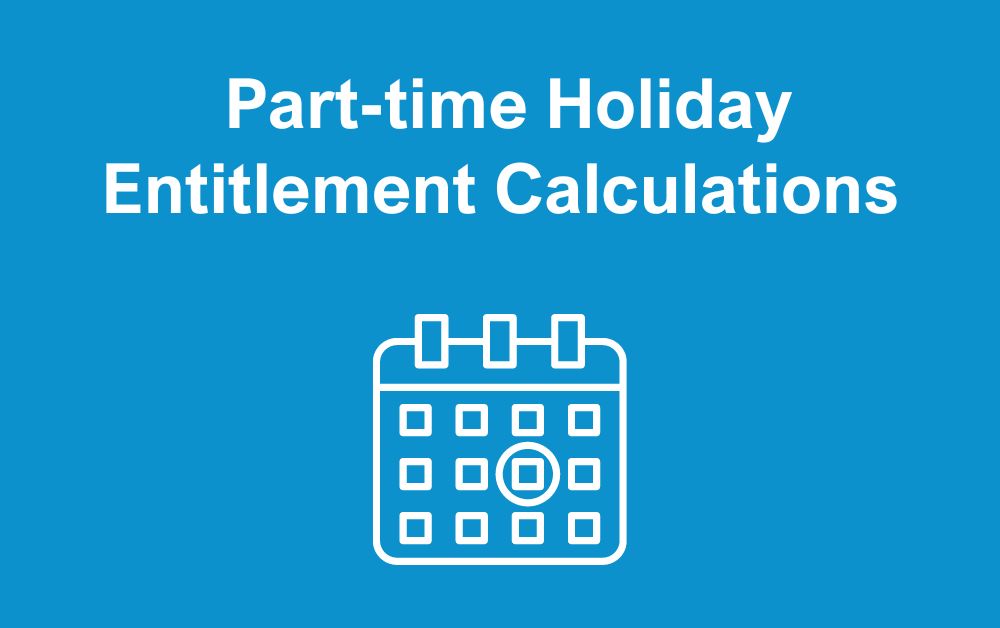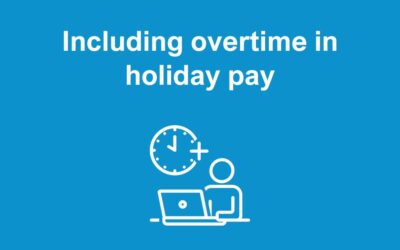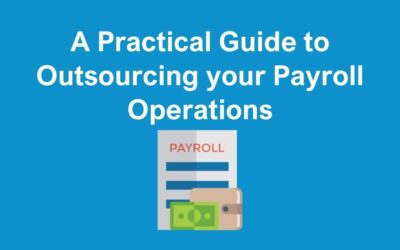How do I calculate holiday entitlement for Part-time workers?
Calculating annual leave entitlement for part time-workers can be confusing when you have lots of staff all working irregular hours. However, it’s important you put everything in place to ensure you get it right as making an error can be off-putting for a new worker.
Holidays are essential for employees to re-charge and avoid burn out. A well rested worker is a more engaged employee. In addition, it’s your responsibility to calculate holiday entitlement correctly and ensure your team take them.
To help you achieve this, we’ve completed an easy guide below.
How to Calculate Holiday entitlement for a part time employee
Part-time workers are entitled to 5.6 week’s paid holiday (statutory leave), but this should be worked out in proportion to the hours they work. If they work 3 days, that’s 16.8 days (3 x 5.6), or 4 days is 22.4 days (4 x 5.6).
Use the simple holiday entitlement calculator to calculate holidays for your part-time employees
Calculating statutory entitlement for part time-workers can be confusing when you have lots of staff all working different hours. However, it’s important you put everything in place to ensure you get it right as making an error can be off-putting for a new employee.
Holiday leave is essential for employees to re-charge and avoid burn out. A well rested employee is a more engaged employee. In addition, it’s your responsibility to calculate holiday entitlement correctly and ensure your team take them.
To help you achieve this, we’ve completed an easy guide below.
How to Calculate Holiday entitlement for Part-time workers
Part-time workers are entitled to 5.6 week’s paid holiday (statutory), but this should be worked out in proportion to the hours they work. If they work 3 days, that’s 16.8 days (3 x 5.6), or 4 days is 22.4 days (4 x 5.6).
Calculate by hours worked: Holiday entitlement calculator for holidays part-time employees based on the hours they work
Holiday entitlement for Irregular Hours and Part-Year Workers
The government has recently updated the way holiday entitlements are calculated for part-year and irregular year workers, addressing longstanding issues in the previous system. This change is aimed at providing a fairer and more accurate method for determining holiday pay for employees who do not have a fixed work pattern throughout the year. Therefore, annual leave accrual for Irregular and part-year workers will be set at 12.07% of the hours worked.
HR Software to calculate holiday entitlement for your full and part-time employees
Getting it wrong can make you look unprofessional, so we always recommend using professional HR software. This allows you to enter individual hours and it works it all out for you. Better still, many programs let staff make requests for time off and keep track of remaining hours to take (and also how overtime has to be included in the holiday pay). There are lots of different ones available and many offer free trials.
Bank Holidays
Bank holidays, also known as public holidays, are fixed dates designated by governments to commemorate significant events, religious observances, or national celebrations. These holidays typically result in the closure of banks, government offices, and many businesses, providing employees with a well-deserved day off. In the United Kingdom, bank holidays include established dates such as Christmas Day, New Year’s Day, and Easter Monday, along with region-specific holidays like St. Andrew’s Day in Scotland.
Bank holidays hold cultural and historical significance, serving as occasions for communities to come together, celebrate traditions, and honour shared heritage. For many people, bank holidays offer an opportunity to relax, spend time with loved ones, and engage in leisure activities. Employers may offer additional benefits such as enhanced pay rates or paid time off in lieu for employees required to work on bank holidays. Overall, bank holidays play a vital role in balancing work and personal life, fostering social cohesion, and enriching the cultural fabric of society.
Irregular Hours
Irregular hours refer to work schedules that deviate from standard or predictable patterns, often involving shifts that vary in duration, timing, or frequency. This arrangement is common in industries such as healthcare, hospitality, retail, and emergency services, where operational needs demand flexibility in staffing. Employees working irregular hours may find themselves working evenings, weekends, or public holidays, necessitating adjustments to their personal lives and routines.
While irregular hours offer flexibility and may accommodate diverse lifestyles or commitments, they can also pose challenges. Employees working irregular hours may experience disruptions to their sleep patterns, struggle to maintain work-life balance, or face difficulties in scheduling personal activities or childcare. Moreover, irregular hours can impact social relationships and limit participation in community or leisure activities.
Employers must carefully manage irregular hours to ensure compliance with working time regulations, mitigate fatigue and burnout risks, and promote employee well-being. Effective communication, transparent scheduling practices, and adequate rest periods are essential to maintaining a healthy work environment for employees working irregular hours. Balancing operational demands with employees’ needs for stability and predictability is crucial in fostering a productive and sustainable workplace culture.
Statutory Leave
Statutory leave encompasses various forms of paid time off mandated by law, ensuring that employees have the opportunity to address personal and family needs without sacrificing income or job security. In the United Kingdom, statutory leave entitlements include annual leave, maternity and paternity leave, sick leave, and adoption leave, among others.
Annual leave provides employees with paid time off for rest, relaxation, and personal pursuits, promoting work-life balance and mental well-being. Maternity and paternity leave allow parents to bond with their newborns and adjust to the demands of parenthood, fostering family cohesion and supporting child development. Sick leave enables employees to recover from illness or injury without financial hardship, safeguarding their health and productivity.
Adoption leave offers adoptive parents the opportunity to bond with their new child and facilitate the transition to a new family dynamic. Additionally, statutory leave provisions may include compassionate leave to cope with bereavement or emergencies, ensuring that employees receive support during challenging times.
By enshrining these entitlements in law, statutory leave provisions uphold principles of fairness, equity, and social responsibility in the workplace, fostering a culture of compassion, respect, and dignity for all employees. Employers play a vital role in facilitating access to statutory leave and promoting a supportive work environment that values employees’ well-being and life outside of work.
Working Time Regulations
Working time regulations are legislative measures implemented to govern the duration, scheduling, and conditions of work for employees. These regulations aim to safeguard workers’ health, safety, and well-being while promoting fair and equitable employment practices. In the United Kingdom and many other countries, working time regulations establish limits on the maximum number of hours employees can work per week, ensuring they have adequate time for rest and recuperation.
Key provisions of working time regulations often include requirements for daily and weekly rest periods, limitations on night work, and provisions for paid annual leave. These regulations also address issues such as breaks during shifts, overtime compensation, and protections for vulnerable workers, including young workers and those in hazardous industries.
By setting clear standards and expectations for working hours and conditions, working time regulations help prevent exploitation, mitigate the risks of fatigue and burnout, and promote work-life balance. Employers are responsible for ensuring compliance with these regulations, which may involve implementing systems for tracking working hours, providing adequate rest breaks, and offering support to employees to manage their workload effectively.
Overall, working time regulations play a crucial role in shaping modern employment practices, fostering healthier, more sustainable workplaces, and supporting the well-being and productivity of the workforce.
Regular Hours
Regular hours refer to a consistent work schedule that adheres to standard patterns, typically spanning Monday to Friday during conventional business hours. This structured approach to work scheduling offers predictability and stability for both employers and employees, facilitating effective planning and coordination of tasks and responsibilities.
For employees, regular hours provide a sense of routine and structure, allowing for better work-life balance and the ability to plan personal and family activities outside of work. The predictability of regular hours also enables employees to establish healthy habits and routines, such as consistent sleep patterns and leisure activities.
From an employer’s perspective, regular hours contribute to operational efficiency, as they facilitate the smooth flow of work and enable effective supervision and coordination of employees. Moreover, regular hours help organisations maintain consistent customer service levels, meet production targets, and ensure adequate staffing levels during peak periods.
Overall, regular hours form the foundation of many workplaces, providing a framework for productivity, collaboration, and work-life balance. While some industries may necessitate flexibility in scheduling, the benefits of regular hours in promoting employee well-being and organisational effectiveness are widely recognised.
The Holiday Year
The holiday year, also known as the leave year or vacation year, represents the annual period during which employees accrue and utilise their entitlement to paid time off for holidays, rest, and personal pursuits. This defined timeframe typically spans 12 consecutive months and serves as a benchmark for tracking and managing employees’ annual leave allowances.
Employers often establish the holiday year to coincide with the financial or calendar year, although variations may occur depending on industry practices or company policies. Setting a consistent holiday year provides clarity and consistency for employees and facilitates administrative processes such as leave planning, scheduling, and tracking.
During the holiday year, employees accumulate leave entitlements based on factors such as length of service, employment status (full-time, part-time), and contractual agreements. Employers are responsible for communicating the holiday year’s start and end dates, as well as any relevant policies regarding leave accrual, carryover, and usage.
Effective management of the holiday year requires balancing operational needs with employees’ rights to time off, ensuring that workload distribution remains equitable and that essential services are maintained. By adhering to fair and transparent leave policies and fostering open communication, employers can promote a positive work environment that prioritises employee well-being and satisfaction.
Casual Workers
Casual workers, also known as temporary or contingent workers, are individuals employed on an ad-hoc or irregular basis to meet short-term staffing needs or address fluctuating workloads. Unlike permanent employees, casual workers typically do not have fixed schedules or guaranteed hours of work. Instead, they are engaged as needed, often on short notice, to perform specific tasks or fill temporary vacancies.
Casual workers provide employers with flexibility in staffing, allowing them to adjust workforce levels in response to changing demand or project requirements. This arrangement benefits employers by reducing overhead costs associated with maintaining a full-time workforce and providing greater agility in adapting to market conditions.
However, casual workers may face uncertainty and instability in their employment, as their hours and income can vary significantly from week to week or month to month. They may also have limited access to benefits such as paid leave, health insurance, or retirement plans, which are typically offered to permanent employees.
Despite these challenges, casual work can offer individuals opportunities for supplemental income, flexibility in scheduling, and exposure to diverse work experiences. Employers must ensure that casual workers are treated fairly, provided with clear expectations and terms of engagement, and afforded basic employment rights in accordance with applicable labour laws and regulations.
Part-Time Workers
Part-time workers are individuals who work fewer hours than full-time employees, typically on a regular basis. Part-time employment arrangements offer flexibility for both employers and employees, accommodating various lifestyles, personal commitments, and career aspirations.
Part-time workers contribute to the workforce in diverse roles across numerous industries, ranging from retail and hospitality to healthcare and professional services. They may choose part-time employment for reasons such as caregiving responsibilities, pursuing education or training, or balancing multiple job commitments.
While part-time workers enjoy flexibility in their schedules, they may also face challenges such as limited access to benefits and advancement opportunities compared to their full-time counterparts. Employers must ensure equitable treatment of part-time employees, including fair compensation, access to training and development opportunities, and consideration for career progression.
Effective management of part-time workers involves clear communication, transparent scheduling practices, and recognition of their contributions to the organization. By fostering a supportive work environment that values part-time employees’ skills and expertise, employers can harness the benefits of a diverse workforce and promote a culture of inclusivity and respect.
Pro-Rata Definition
Pro rata, derived from Latin, means “in proportion” or “according to a specific rate.” In employment contexts, pro rata is used to calculate benefits, entitlements, or payments for part-time or temporary workers based on their proportion of full-time hours or duration of employment.
For example, when determining annual leave entitlements for part-time employees, their entitlement is calculated pro rata based on the number of hours they work compared to full-time employees. Similarly, salary, bonuses, and other benefits may be pro-rated to reflect the proportion of time worked or duration of employment.
Pro rata calculations ensure that part-time or temporary workers receive fair and equitable treatment relative to their full-time counterparts. By adjusting entitlements and benefits in proportion to the hours worked or length of service, employers uphold principles of fairness and consistency in their employment practices.
Understanding pro rata calculations is essential for employers to comply with employment legislation and contractual obligations. By accurately implementing pro rata adjustments, employers demonstrate their commitment to treating all employees fairly and transparently, regardless of their employment status or working arrangements.
Variable Hours
Variable hours refer to work schedules that fluctuate over time, often in response to changing business demands, seasonal variations, or employee preferences. This arrangement provides flexibility for both employers and employees, allowing for adjustments in work hours to accommodate evolving needs or circumstances.
Employers may utilize variable hours to optimize workforce deployment, ensuring that staffing levels align with operational requirements without incurring unnecessary costs. This flexibility enables businesses to adapt to fluctuations in customer demand, production schedules, or project deadlines more efficiently.
For employees, variable hours offer opportunities to customize their work schedules to suit their individual preferences, lifestyles, and commitments. This flexibility can be particularly beneficial for students, caregivers, or individuals with multiple job responsibilities.
However, variable hours can also pose challenges, such as uncertainty in income, difficulty in planning personal activities, or disruptions to work-life balance. Employers must ensure transparent communication, fair scheduling practices, and compliance with relevant employment laws to mitigate these challenges and support the well-being of their workforce.
By effectively managing variable hours, employers can optimize productivity, retain talented employees, and foster a positive work environment that values flexibility, adaptability, and mutual respect.
We are gold partners of Breathe HR and we highly recommend trying it out for your company. Breathe offers a holiday management system to avoid stress, and to give employees the ability to track their holiday entitlement and request time off. The holiday calendar also allows you to track when your team are off. Contact us now if you would like a free trial.






